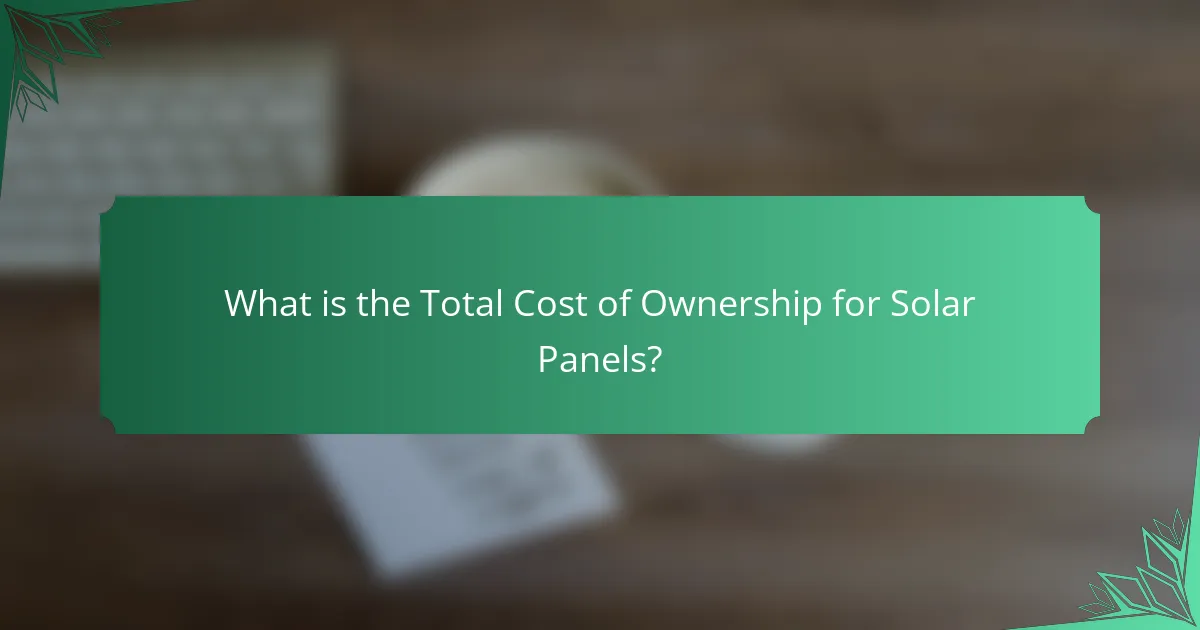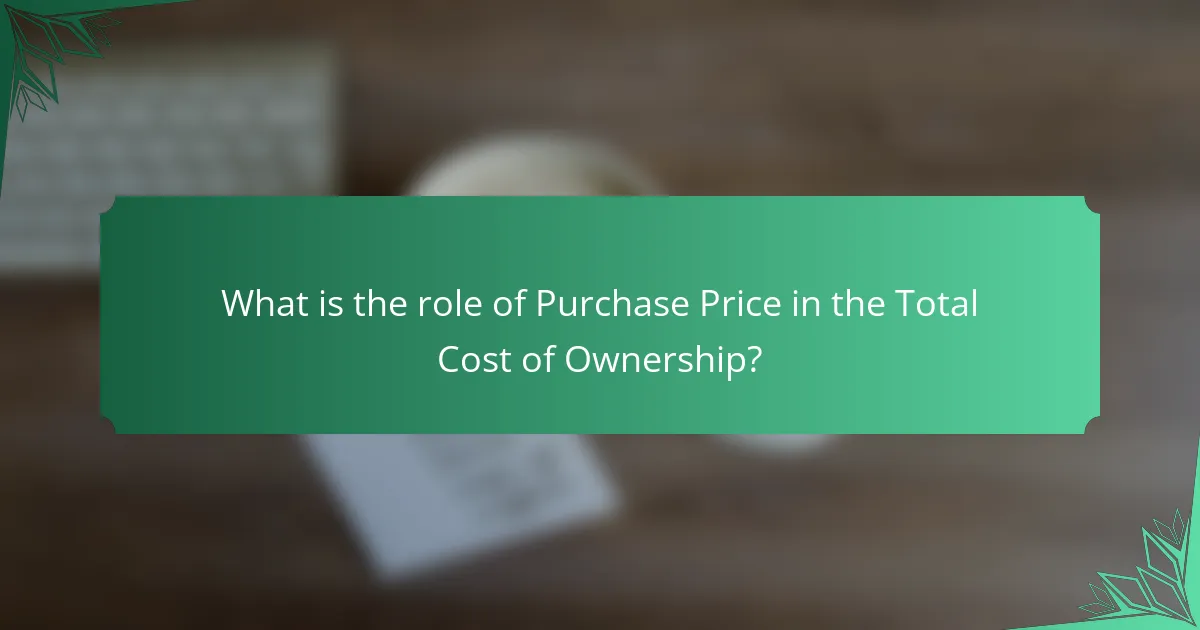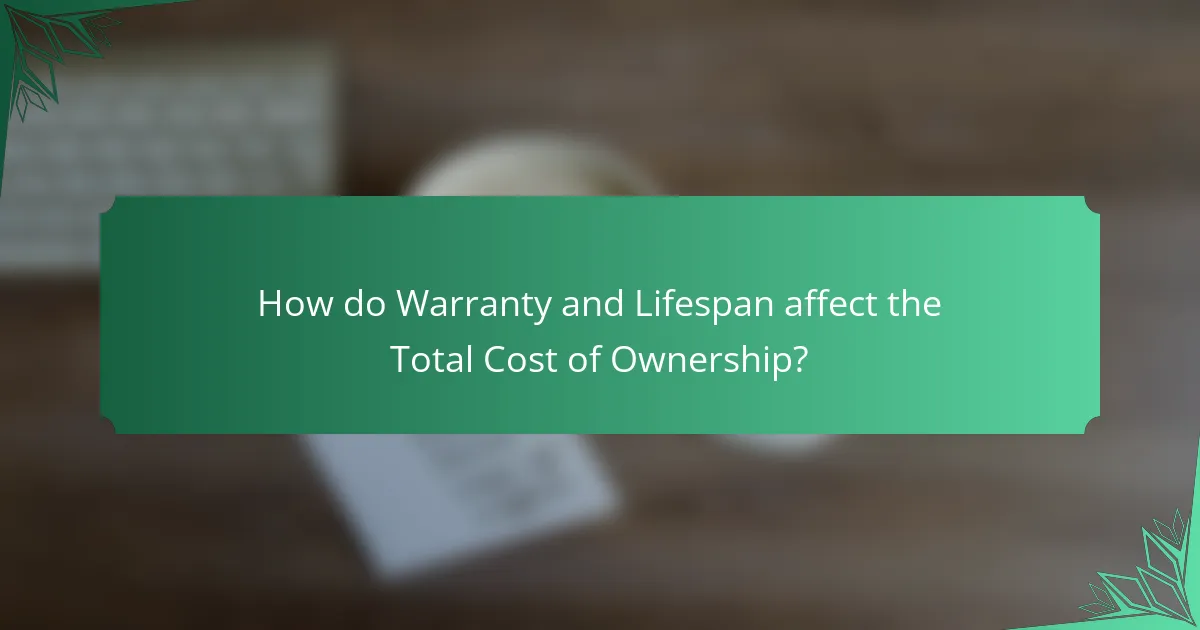
What is the Total Cost of Ownership for Solar Panels?
The Total Cost of Ownership (TCO) for solar panels includes the purchase price, installation costs, maintenance, and operational expenses. The average purchase price for residential solar panel systems ranges from $15,000 to $25,000 before incentives. Installation costs can add an additional 10-20% to the total. Maintenance costs are generally low, averaging around $300 annually. The lifespan of solar panels is typically 25 to 30 years, providing long-term savings on energy bills. Tax credits and incentives can significantly reduce the initial costs, further impacting TCO. Overall, calculating TCO helps homeowners assess the financial viability of solar investments.
How is the Total Cost of Ownership calculated for solar panels?
The Total Cost of Ownership (TCO) for solar panels is calculated by summing all costs associated with the purchase, installation, maintenance, and operation over the system’s lifespan. This includes the initial purchase price of the solar panels and installation fees. Additional costs such as permits, inspections, and any necessary upgrades to electrical systems are also included.
Maintenance costs, which can include cleaning and repairs, should be factored in as well. The lifespan of solar panels, typically around 25 to 30 years, is considered to calculate annualized costs.
Energy savings from reduced electricity bills are subtracted from the total costs to determine net ownership costs. This approach provides a comprehensive view of the financial commitment involved in solar panel ownership.
What are the key components that contribute to the Total Cost of Ownership?
The key components that contribute to the Total Cost of Ownership (TCO) for solar panels include purchase price, installation costs, maintenance expenses, and operational costs. Purchase price refers to the initial expenditure to acquire the solar panels. Installation costs encompass labor and any additional materials required for setup. Maintenance expenses involve periodic checks and repairs to ensure optimal performance. Operational costs include expenses related to energy production and any potential system upgrades. According to the National Renewable Energy Laboratory, these factors collectively determine the long-term financial viability of solar panel investments.
How do installation costs impact the Total Cost of Ownership?
Installation costs significantly affect the Total Cost of Ownership (TCO) for solar panels. High installation costs increase the initial expenditure, which directly raises the TCO. For instance, if installation costs are $10,000, this amount is added to the purchase price of the solar panels. The TCO includes not only the purchase price but also installation, maintenance, and operational costs over the system’s lifespan. A study by the National Renewable Energy Laboratory indicates that installation costs can account for up to 30% of the total investment in solar systems. Therefore, higher installation costs can lead to longer payback periods and lower return on investment. In contrast, lower installation costs can enhance financial viability and speed up the breakeven point.
Why is understanding the Total Cost of Ownership important for solar panel buyers?
Understanding the Total Cost of Ownership (TCO) is crucial for solar panel buyers because it encompasses all expenses associated with solar energy systems. TCO includes the initial purchase price, installation costs, maintenance, and potential savings over time. By evaluating TCO, buyers can make informed decisions about their investment. It allows them to compare different solar products and services accurately. For instance, a lower upfront cost may lead to higher long-term expenses if maintenance is costly. Research shows that considering TCO can lead to a more sustainable financial outcome. Buyers who understand TCO are better equipped to assess the true value of solar panels. This understanding ultimately supports long-term energy savings and financial benefits.
What financial benefits can be gained from evaluating the Total Cost of Ownership?
Evaluating the Total Cost of Ownership (TCO) provides significant financial benefits. It enables accurate budgeting by accounting for all costs associated with solar panels. This includes purchase price, installation, maintenance, and operational expenses. By understanding TCO, consumers can identify long-term savings. For example, solar panels can reduce electricity bills significantly over their lifespan. Studies indicate that homeowners can save up to 70% on energy costs with solar installations. Additionally, TCO evaluation can reveal hidden costs, preventing unexpected financial burdens. Overall, assessing TCO leads to informed financial decisions and maximizes return on investment.
How does the Total Cost of Ownership influence long-term investment decisions?
Total Cost of Ownership (TCO) significantly influences long-term investment decisions by providing a comprehensive view of all costs associated with an asset. TCO includes the initial purchase price, installation costs, maintenance, operational expenses, and potential disposal costs. Investors consider TCO to assess the true financial impact over the asset’s lifespan. For example, a solar panel system may have a higher upfront cost but lower operational costs, resulting in a favorable TCO. Research indicates that understanding TCO can lead to better investment choices, as it emphasizes long-term savings over short-term expenses. This approach allows for more accurate forecasting of return on investment, guiding stakeholders in making informed decisions.

What is the role of Purchase Price in the Total Cost of Ownership?
The purchase price is a critical component of the Total Cost of Ownership (TCO) for solar panels. It represents the initial investment required to acquire the solar system. A lower purchase price can reduce the overall TCO, making solar energy more accessible. However, the purchase price alone does not determine the TCO. Factors such as installation costs, maintenance, and energy savings also play significant roles. According to a study by the National Renewable Energy Laboratory, the purchase price can account for 30-50% of the TCO over the lifespan of solar panels. Therefore, while the purchase price is essential, it must be evaluated alongside other cost factors to assess the true financial impact of solar panel ownership.
How does the Purchase Price of solar panels vary across different brands?
The purchase price of solar panels varies significantly across different brands. For instance, premium brands like SunPower may charge between $2.50 to $3.50 per watt. Mid-range brands such as LG typically range from $2.00 to $3.00 per watt. Budget brands like Canadian Solar can offer prices as low as $1.50 to $2.00 per watt. Variations in pricing are influenced by factors like efficiency, warranty length, and technology used. The average cost for residential solar panel installations in the U.S. is around $3.00 per watt as of 2023. This data reflects market trends and consumer choices across the industry.
What factors affect the Purchase Price of solar panels?
The purchase price of solar panels is affected by factors such as panel type, efficiency, and brand reputation. Different panel types include monocrystalline, polycrystalline, and thin-film, each with varying costs. Higher efficiency panels generally cost more due to advanced technology. Brand reputation influences price, as established brands may charge a premium for reliability. Additionally, installation costs and local incentives also impact the overall purchase price. Market demand and supply fluctuations can lead to price changes as well. Government policies and tariffs may further affect solar panel pricing.
How can buyers negotiate the Purchase Price effectively?
Buyers can negotiate the purchase price effectively by conducting thorough market research. Understanding current market rates for solar panels helps establish a baseline for negotiations. Buyers should gather quotes from multiple suppliers to compare prices and terms. This approach provides leverage during discussions. Buyers can also highlight any competing offers to strengthen their negotiating position. Additionally, emphasizing the potential for bulk purchases may lead to discounts. Building a rapport with the seller can create a more favorable negotiation environment. Lastly, being prepared to walk away can empower buyers to secure a better deal.
What are the long-term implications of the Purchase Price on overall costs?
The long-term implications of the purchase price on overall costs are significant. A higher initial purchase price can lead to increased long-term savings if the solar panels are more efficient and durable. For example, premium solar panels often have better warranties and longer lifespans, which can reduce maintenance and replacement costs over time. Conversely, a lower purchase price may result in higher operational costs due to lower efficiency and shorter lifespan. Studies indicate that investing in higher-quality solar panels can yield up to 20% more energy over their lifetime. Therefore, the purchase price directly influences the total cost of ownership through efficiency, durability, and maintenance requirements.
How does a higher Purchase Price correlate with quality and performance?
A higher purchase price typically correlates with improved quality and performance in solar panels. Premium solar panels often utilize advanced materials and technologies. These enhancements lead to better energy efficiency and output. For instance, high-quality panels can achieve efficiency rates exceeding 20%. In contrast, lower-priced options may only reach around 15%. Additionally, higher-priced panels often come with longer warranties, indicating manufacturer confidence in durability. Research by the National Renewable Energy Laboratory shows that premium panels have lower degradation rates. This results in better long-term performance and energy generation. Thus, the purchase price is a strong indicator of overall quality and performance in solar panels.
What financing options are available to manage the Purchase Price?
Common financing options to manage the purchase price of solar panels include solar loans, leases, and power purchase agreements (PPAs). Solar loans allow homeowners to borrow money to buy solar panels, often with fixed monthly payments. Leases enable users to rent solar panels, paying a monthly fee without ownership. PPAs involve paying for the electricity generated by the solar panels at a predetermined rate. These options can reduce upfront costs and make solar energy more accessible. Many states offer incentives and tax credits that further lower the effective purchase price, enhancing affordability.

How do Warranty and Lifespan affect the Total Cost of Ownership?
Warranty and lifespan significantly impact the total cost of ownership (TCO) of solar panels. A longer warranty typically indicates higher quality and reliability. This reduces the likelihood of unexpected repair costs. Extended warranties may also cover maintenance, further lowering the TCO. Lifespan influences how long the panels will generate energy before replacement is necessary. Longer-lasting panels spread the initial investment over more years of energy production. According to the National Renewable Energy Laboratory, solar panels can last 25 years or more, maximizing their value. Overall, both warranty and lifespan are critical factors in calculating the total cost of ownership for solar panels.
What types of warranties are offered with solar panels?
Solar panels typically come with three main types of warranties: product warranty, performance warranty, and installation warranty. The product warranty covers defects in materials and workmanship, usually lasting 10 to 25 years. The performance warranty guarantees a certain level of energy output over a specified period, often 25 years. The installation warranty, offered by the installer, ensures the quality of the installation work, typically ranging from 1 to 10 years. These warranties protect consumers from potential issues and ensure the longevity and efficiency of the solar panels.
How do different warranty terms influence consumer choices?
Different warranty terms significantly influence consumer choices regarding solar panels. Longer warranty periods often enhance consumer confidence in the product’s reliability. Consumers perceive extended warranties as a safeguard against potential defects or failures. For example, a 25-year warranty may lead to higher purchase intent compared to a 5-year warranty. Studies show that consumers are willing to pay a premium for products with better warranty terms. A survey indicated that 70% of buyers consider warranty length crucial in their decision-making process. Furthermore, warranties can serve as a differentiator in a competitive market. Brands offering superior warranty terms often gain a competitive edge. Thus, warranty terms play a critical role in shaping consumer purchasing behavior.
What should consumers look for in a warranty?
Consumers should look for coverage duration, specific components included, and claims process clarity in a warranty. A warranty should clearly state how long it lasts, typically ranging from 10 to 25 years for solar panels. It should specify which parts are covered, such as the inverter and panels, to avoid unexpected costs. Additionally, consumers should assess the claims process, ensuring it is straightforward and timely. Transparency in terms and conditions is essential for understanding limitations and exclusions. Research indicates that warranties significantly influence consumer trust, with 70% of buyers considering warranty length a critical factor in their purchase decision.
How does the lifespan of solar panels impact their Total Cost of Ownership?
The lifespan of solar panels significantly impacts their Total Cost of Ownership (TCO). A longer lifespan reduces the annualized cost of the initial investment. Typically, solar panels last 25 to 30 years. The TCO calculation includes the purchase price, maintenance costs, and energy savings over time.
For example, if a solar panel system costs $15,000 and lasts 25 years, the annualized cost is $600. If the system lasts 30 years, the annualized cost drops to $500. This reduction in annualized cost improves the overall return on investment.
Additionally, warranties often align with the lifespan. Most manufacturers provide a 25-year warranty. This assurance can lower maintenance costs, further enhancing TCO. Therefore, a longer lifespan directly correlates with lower TCO and improved financial viability.
What is the average lifespan of solar panels and how does it vary?
The average lifespan of solar panels is between 25 to 30 years. This lifespan can vary based on factors such as the quality of materials used and environmental conditions. Higher-quality panels often last longer than lower-quality ones. Additionally, solar panels installed in harsher climates may experience a reduced lifespan. Regular maintenance can also influence longevity. Most manufacturers provide warranties that reflect these lifespan estimates, typically ranging from 20 to 25 years. Performance degradation occurs over time, with panels typically losing about 0.5% to 1% efficiency per year.
How does lifespan affect maintenance and replacement costs?
Lifespan significantly impacts maintenance and replacement costs for solar panels. A longer lifespan reduces the frequency of replacements, leading to lower overall costs. For instance, solar panels typically have a lifespan of 25 to 30 years. If panels last this duration, the need for replacement is minimized, which saves on capital expenditures. Conversely, shorter lifespans necessitate more frequent replacements, increasing costs over time. Additionally, maintenance costs can vary based on lifespan. Panels that last longer may require less frequent servicing, thereby reducing ongoing maintenance expenses. Research indicates that maintaining solar panels can cost around 1% of the initial investment annually. Thus, the longer the lifespan, the more cost-effective the maintenance and replacement strategy becomes.
What practical tips can help consumers evaluate the Total Cost of Ownership for solar panels?
To evaluate the Total Cost of Ownership for solar panels, consumers should consider several key factors. First, assess the initial purchase price, which includes equipment and installation costs. Next, analyze potential energy savings over time, as solar panels can significantly reduce electricity bills.
Additionally, consider the warranty period offered by manufacturers. A longer warranty often indicates higher quality and reliability. Evaluate the lifespan of the solar panels, typically around 25 to 30 years, to understand long-term value.
Lastly, factor in maintenance costs, which are generally low but can vary based on location and system type. Research shows that the average maintenance cost for solar panels is about $15 to $30 per year. By considering these elements, consumers can gain a comprehensive understanding of the Total Cost of Ownership for solar panels.
The main entity of this article is the Total Cost of Ownership (TCO) for solar panels, which encompasses the purchase price, installation costs, maintenance expenses, and operational costs over the system’s lifespan. The article provides a detailed analysis of how these components influence the financial viability of solar investments, emphasizing the importance of understanding TCO for homeowners considering solar energy. Key factors such as warranty terms, lifespan, and potential energy savings are examined to guide consumers in making informed decisions about solar panel purchases. The evaluation of TCO is essential for maximizing long-term savings and ensuring a sustainable investment in solar technology.